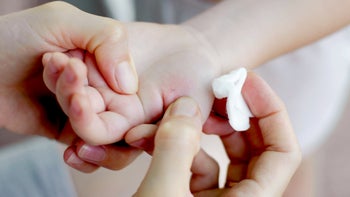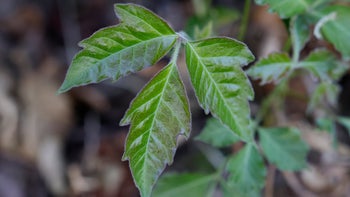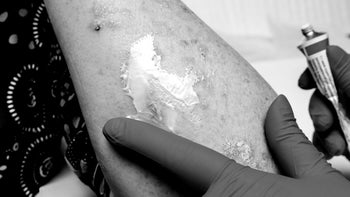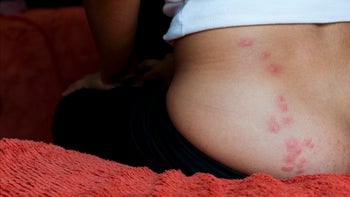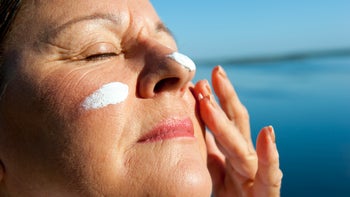
12 Remedies That Can Get Rid of Mosquito and Other Bug Bites Fast
Key takeaways:
Home remedies for mosquito bites and other bug bites include baking soda paste, calamine lotion, and hydrocortisone cream.
Over-the-counter (OTC) pain relievers and antihistamines can also provide relief from bug bite symptoms.
Seek medical care if bug bite home remedies aren’t relieving your symptoms or if you think you might have infected bug bites.
Table of contents

When the weather warms up or when you spend time outside, you’re more likely to come into contact with mosquitoes, spiders, ticks, bees, and other flying insects. One thing these bugs all have in common: They can leave itchy, uncomfortable bug bites behind.
There’s no way to get rid of bug bites overnight. Most bug bites take a few days to go away. But there are things you can do at home to relieve itching and help bug bites fade faster.
Here are 12 remedies that can get rid of bug and mosquito bite symptoms fast.
Search and compare options
1. OTC pain relievers
Acetaminophen (Tylenol) and ibuprofen (Motrin, Advil) are over-the-counter (OTC) pain relievers that can help with painful bug bites. They won’t relieve itching, but they can help with warmth, pain, and swelling.
Tylenol can take up to 45 minutes to start working. You can take 1 dose every 4 to 6 hours, but adults shouldn’t take more than 4,000 mg in 24 hours.
Motrin can start to work in 30 minutes. In addition to pain relief, ibuprofen can help reduce swelling. Adults and kids over age 12 can take Motrin every 6 to 8 hours. But you shouldn’t take more than 1,200 mg in 24 hours.
2. Antihistamines
After a bug bite, your body releases histamine. This chemical causes the itch from a bug bite.
Antihistamines are medications that block the release of histamine. Antihistamines are available as topical creams and oral tablets or suspensions. But topical creams don’t seem to work as well as antihistamines taken by mouth. So it’s probably best to take antihistamines by mouth to help get rid of bug bite symptoms fast.
There are many types of oral antihistamines. But one study showed that cetirizine (Zyrtec) is the best antihistamine for itching. You can take cetirizine daily until your bite goes away. If itching is keeping you up at night, you can try taking diphenhydramine (Benadryl) at bedtime. Diphenhydramine can cause sleepiness and sedation, so it’s best to avoid it during the day.
Are you a mosquito magnet? Here are some reasons why it feels like you’re getting bitten more than others.
Mosquito bites vs. bed bug bites: These pictures will help you know what’s been biting you.
Do natural mosquito repellants really work? Find out which home remedies are most effective at preventing bug bites.
3. Hydrocortisone cream
Hydrocortisone cream is a steroid cream that can relieve itching from skin problems like psoriasis, eczema, and poison ivy. It’s not as well studied for treating itching from bug bites. But it’s FDA approved for bug bite relief. And many health experts recommend its use for getting rid of bug bite symptoms fast.
You can put hydrocortisone cream on a bug bite twice daily, but you shouldn’t use it for more than a week. Low-strength hydrocortisone cream is available OTC at local pharmacies and retail stores.
4. Baking soda
You can put baking soda on bug bites to stop the itching. Baking soda (sodium bicarbonate) helps neutralize the acid produced by a bite. Here’s how to make a baking soda paste at home:
Mix a tablespoon of baking soda with water to make a paste.
Lay the paste over the bug bite and let it sit for 10 minutes.
Once the 10 minutes are up, rinse it off.
Read more like this
Explore these related articles, suggested for readers like you.
Baking soda paste is an easy and safe home remedy for bug bites. You can apply the paste several times a day.
5. Calamine lotion
Calamine lotion, like baking soda, neutralizes the acid produced by bug bites. To relieve itching, apply calamine lotion to bug bites with a cotton ball several times daily.
You can use calamine lotion for children over the age of 2. But be careful: The pink liquid can appeal to kids, so only apply it with supervision. If your child swallows it by accident, contact Poison Control right away at 1-800-222-1222.
6. Cool compresses
Cool compresses lower the skin temperature to reduce swelling and calm the nerves responsible for that itchy feeling. Make a cold compress by wrapping an ice pack in a towel or rinsing a washcloth in cold water. You can apply a cold compress to the skin for 5 to 10 minutes at a time.
7. Oatmeal paste
Oatmeal isn’t just a nutritious breakfast: It’s also a skin-soothing powerhouse. Oatmeal contains compounds called avenanthramides. These have natural anti-inflammatory properties and can stop bug bite itching fast. When mixed with water to form a paste, oatmeal can be applied directly to mosquito or bug bites to reduce itching and calm irritated skin.
If you have a lot of bug bites or are just looking for more coverage, you can also try an oatmeal bath. Just toss a cup of plain, unflavored oatmeal into a warm bath and soak for 15 to 20 minutes. It’s a gentle, effective way to get relief from your bug bites without needing anything fancy.
8. Rubbing alcohol
If you need quick relief, rubbing alcohol can be a helpful option. When applied to a fresh bite, rubbing alcohol evaporates quickly. This creates a cooling sensation that can temporarily relieve itching. It also disinfects the area, which can help prevent you from getting an infection.
That said, alcohol can dry out your skin and can be irritating to sensitive skin, especially if it’s overused. If you’re going to try rubbing alcohol, use a cotton ball to apply just a small amount to the bite. And avoid using it on broken or irritated skin. Follow up with a moisturizer if you notice any dryness.
9. Chamomile tea bags
Chamomile has long been used for its anti-inflammatory effects, and that extends to bug bites as well. The natural compounds in chamomile help reduce swelling, redness, and itchiness, making it a soothing remedy for irritated skin.
To use it, steep a chamomile tea bag in hot water, then let it cool completely. Or, better yet, chill it in the fridge. Once it’s cool, place the tea bag directly on the bite for several minutes. These chamomile compresses are a gentle, skin-friendly approach that’s especially good for children or those with sensitive skin.
10. Aloe vera
Aloe vera is a time-tested remedy for irritated skin, including bug bites. The gel inside the aloe plant is packed with anti-inflammatory and cooling properties that can help reduce swelling, redness, and itching. It's also antimicrobial, which makes it helpful for preventing infection.
To use it, apply pure aloe vera gel directly to the bite. You can get this straight from the plant by snapping one of its leaves. Or you can buy a product labeled “100% aloe vera.” Aloe vera absorbs quickly and provides fast, soothing relief.
11. Witch hazel
Witch hazel is a natural astringent (meaning it tightens the skin). It’s derived from the bark of the Hamamelis shrub. It contains tannins that can help reduce inflammation and ease itching. Witch hazel is often used in OTC skin care products because of its gentle soothing effects. To use witch hazel for bug bites, apply it with a cotton ball directly to the irritated area.
12. Tea tree oil
Tea tree oil is an essential oil known for its anti-inflammatory, antiseptic, and even insect-repellent properties. When tea tree oil is diluted and applied to the skin, it can help reduce itching and lower the chance of infection at the site of a bug bite.
Apply a drop or two of diluted tea tree oil to the affected area with a cotton swab. Be cautious not to use it undiluted though. This can cause irritation, especially for people with sensitive skin.
What doesn’t help with bug bites?
Not all home remedies are effective for treating bug and mosquito bites. Let’s look at a few treatments that probably won’t help get rid of your bug bite symptoms.
Basil
Basil leaves have anti-inflammatory and immune-modulating properties. And studies have shown that basil leaf extract may repel insects. But there’s no research to support using basil leaf oil to treat bug bites.
Honey
Researchers have studied honey's anti-inflammatory and antibacterial properties to treat various health conditions. Medical-grade honey, in particular, can be used in wound care. But research on using honey for bug bites is lacking.
Onions
Many people have experienced watering eyes from sliced onions. And research has shown that the juice from an onion can irritate bugs too. So onions may be useful as a bug repellent. But no studies have tested the effectiveness of putting onion slices over a bug bite for itch relief.
Thyme
This popular cooking herb has anti-inflammatory properties. Researchers have noted its ability to kill bacteria, fungi, and parasites, as well as some viruses. Plus, thyme oil can act as an insect repellant. But like other home remedies on this list, research on its effectiveness for bug bite relief is sparse.
Toothpaste
Some toothpaste contains menthol, an ingredient which can temporarily provide cooling itch relief. However, menthol, fluoride, and other whitening agents in toothpaste can also irritate the skin. That’s why toothpaste isn’t the best choice when it comes to home remedies for bug bite relief.
Vinegar
Vinegar may produce a cooling effect when applied to a bug bite. However, vinegar has no compounds that reduce inflammation or treat itch. Vinegar is also acidic and can irritate the skin. There isn’t evidence to support using vinegar to treat bug bites.
What should you do after you get bit by a bug?
After a bug bite, follow these steps to clean the area and relieve itching and pain fast:
Wash the area with unscented soap and water.
Pat the skin dry.
Apply a cool compress for 10 to 15 minutes.
Try a home remedy like topical calamine lotion or hydrocortisone cream.
Use an oral pain reliever or antihistamine.
When should you seek care for a bug bite?
Call 911 if after a bug bite you have signs of anaphylaxis, a severe allergic reaction. Signs of anaphylaxis include:
Trouble breathing
Swelling of the mouth or tongue
Trouble swallowing
Abdominal pain and vomiting
Hives
You should also get help if you live in a place where bugs may be venomous or transmit infection. In the U.S., complications from bug bites include Lyme disease from tick bites, viral infections from mosquitoes, and venomous spider bites.
Seek immediate medical care if you develop signs of a skin infection, like:
Fever
Chills
Redness extending from the bite areas
Severe swelling and tenderness at the bite site
Signs of infection may develop within hours or days after a bug bite.
Frequently asked questions
It’s possible for mosquito bites to transmit serious illnesses. In the U.S., mosquitoes can carry viruses like West Nile, dengue, and, more rarely, Zika. In other parts of the world (especially tropical regions), bites can spread malaria, yellow fever, and chikungunya. Not every bite leads to infection. But it’s smart to protect yourself, especially when traveling to high-risk areas.
If you feel like mosquitoes always find you first, you’re probably not imagining it. Mosquitoes are attracted to body heat, carbon dioxide from your breath, and certain body odors. Other things that can make you more attractive to mosquitos are differences in:
Blood type
Genetics
Sweat
Skin bacteria
Because of this, some people are just more "delicious" to mosquitoes.
Squeezing a mosquito bite might seem like the right thing to do, but it can actually make things worse. Applying pressure or trying to "pop" the bite can cause breakages in your skin barrier, which increases the risk of infection.
Instead of squeezing your mosquito bite, focus on soothing the itch with remedies like hydrocortisone cream, antihistamines, or a cool compress. Keeping the area clean and resisting the urge to scratch will help your skin heal faster and reduce the chance of complications.
The bottom line
Bug bites are itchy and bothersome, but they can usually be treated at home. Home remedies for bug bites include baking soda paste, cold compresses, hydrocortisone cream, and calamine lotion. OTC pain relievers and antihistamines are also effective ways to get fast bug bite relief. Regardless of the remedy that you use, most bug bites will go away in a few days.
Why trust our experts?



References
Adnani, B., et al. (2021). Potential test of ethanol extract from onion (Allium Cepa L) leaves as a repellent to Aedes Aegypti. Journal of Islamic Medicine.
Better Health. (2022). Allergies to bites and stings. Victoria Department of Health.
Carson, C. F., et al. (2006). Melaleuca alternifolia (Tea Tree) oil: A review of antimicrobial and other medicinal properties. Clinical Microbiology Reviews.
Centers for Disease Control and Prevention. (2024). About mosquito bites.
Centers for Disease Control and Prevention. (2024). Mosquito-borne diseases in workers.
Centers for Disease Control and Prevention. (2024). Venomous spiders at work.
Columbia Doctors. (2023). How to stop bug bites from itching. Columbia University.
Does, A. V., et al. (2022). Update on mosquito bite reaction: Itch and hypersensitivity, pathophysiology, prevention, and treatment. Frontiers in Immunology.
Eschler, D. C., et al. (2010). An evidence-based review of the efficacy of topical antihistamines in the relief of pruritus. Journal of Drugs in Dermatology.
Gupta, P., et al. (2022). Preparation of Thymus vulgaris (L.) essential oil nanoemulsion and its chitosan encapsulation for controlling mosquito vectors. Scientific Reports.
Husna, I., et al. (2020). Utilization of basil leaf extract as anti-mosquito repellent: A case study of total mosquito mortality (Aedes aegypti 3rd Instar). Journal of Physics Conference Series.
Jaramillo, V. I., et al. (n.d.). Activity: Taking the sting out of bites.
Kamelnia, E., et al. (2022). Anti-inflammatory, immunomodulatory and anti-oxidant effects of Ocimum basilicum L. and its main constituents: A review. Iranian Journal of Basic Medical Sciences.
Kowalczyk, A., et al. (2020). Thymol and thyme essential oil—new insights into selected therapeutic applications. Molecules.
Liu, B. (2018). Cooling the itch via TRPM8. Journal of Investigative Dermatology.
Ludmann, P., et al. (2024). 10 reasons your skin itches uncontrollably and how to get relief. American Academy of Dermatology Association.
Mandal, M. D., et al. (2011). Honey: Its medicinal property and antibacterial activity. Asian Pacific Journal of Tropical Biomedicine.
McKay, D. L., et al. (2006). A review of the bioactivity and potential health benefits of chamomile tea (Matricaria recutita L.). Phytotherapy Research.
National Health Service. (2023). Insect bites and stings.
Patel, R. H., et al. (2023). Biochemistry, histamine. StatPearls.
Pray, S. W. (2009). Appropriate use of nonprescription hydrocortisone. U.S. Pharmacist.
Soto, P. (n.d.). Can menthol have harmful effects? Poison Control.
Sur, R., et al. (2008). Avenanthramides, polyphenols from oats, exhibit anti-inflammatory and anti-itch activity. Archives of Dermatological Research.
Tashkandi, A. (2021). Honey in wound healing: An updated review. Open Life Sciences.
The Nutrition Source. (2019). Vinegar. Harvard School of Public Health.
Thring, T. S., et al. (2011). Antioxidant and potential anti-inflammatory activity of extracts and formulations of white tea, rose, and witch hazel on primary human dermal fibroblast cells. Journal of Inflammation.
Vázquez, B., et al. (1996). Antiinflammatory activity of extracts from Aloe vera gel. Journal of Ethnopharmacology.







